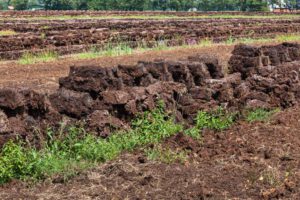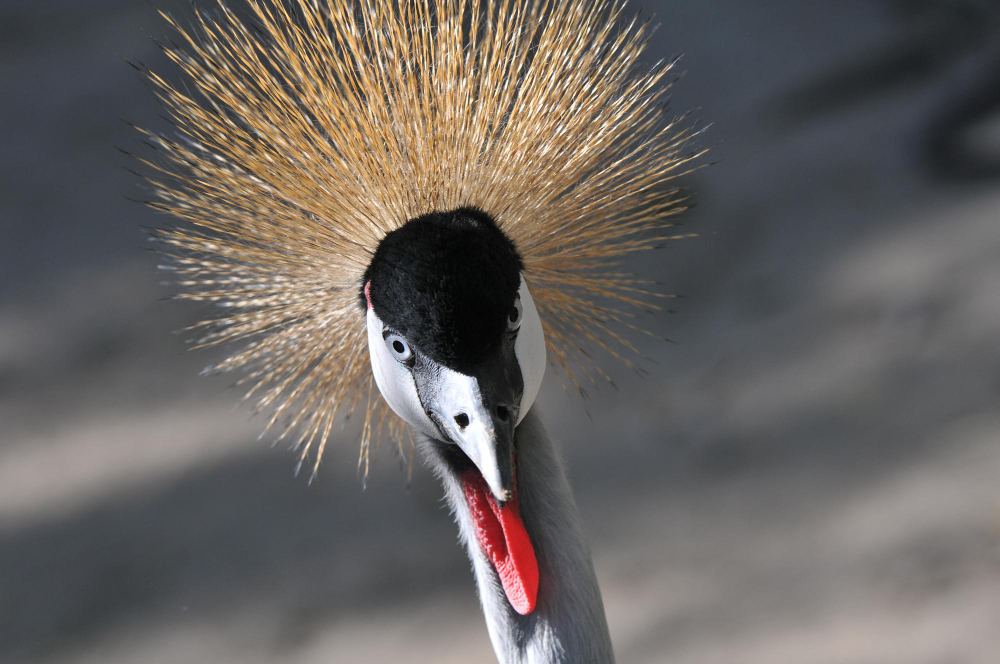Peat extraction
What is peat?
Peat is a mineral, like coal and oil, and its extraction is an irreversible process. This makes peat a non-renewable, fossil product. Essentially, peat is simply dried peat—the remains of ancient plants, compressed into a spongy material. It is primarily mined in the Baltic States, Scandinavia, and—until recently—in Ireland, where it is extracted from deep within drained peatlands.

The horticultural industry loves peat, and for good reason. Peat is incredibly light and dirt-cheap, making it attractive for mass production. Thanks to peat, growers can grow plants for next to nothing and sell potting soil as cheaply as possible. Moreover, peat retains moisture well, but it contains few nutrients that plants need to grow. This last point is convenient for the sector that prefers to add precisely dosed fertilizers themselves to maintain maximum control over growth and production.
In other words, peat makes plant production more efficient and profitable, but the ecological consequences are disastrous.
For the record: plants don't need peat to grow well. There are countless alternatives that don't require us to deplete ecosystems and are better for both your plants and the planet. The choice is ours.

Peat extraction
Peat extraction leads to the destruction of entire natural areas. The habitats of birds, snakes, and insects are completely lost in peat extraction. First, the area is drained. Then, the peat is mined layer by layer. Meters deep, the machines dig their way through the ancient soil, through layers that have existed for thousands of years. The soil is ground, processed, and sold. For potting soil, for a bit of profit on the balance sheet.
What remains are gaping wounds in the landscape. No fertile soil, no regenerating swamp. Only bare, lifeless craters remain like scars in the earth. The water doesn't return. The animals don't return.
And for what? For a hydrangea on the windowsill, a basil plant in the kitchen, a violet in the garden. A fraction of beauty, bought with the soul of a centuries-old landscape.
In this article by investigative journalists Nathalie Bertrams, Ingrid Gercama and Tristen Taylor, the authors reveal that peat extraction is still taking place in previously undrained areas.
The catastrophic consequences of peat extraction

1. Disastrous for our climate
Peat is a fossil material that takes thousands of years to form. When a peatland is drained, oxygen can enter the peat, causing it to oxidize. This releases significant CO₂, which contributes significantly to climate change. Peatlands are disappearing rapidly worldwide, partly to produce peat, which is widely used in potting soil. This destruction accounts for at least 5% of total greenhouse gas emissions. That’s more than all aviation combined!

2. Huge loss of biodiversity
Peat extraction is destroying priceless biodiversity. Peatlands are home to a wealth of life: rare orchids, carnivorous plants, snipe, deer, and butterflies. When peat is extracted, these unique habitats disappear forever. Although the animals and plants in peatlands may not have the same 'cuddly' quality as a panda or orangutan from the tropical rainforest, they deserve protection just as much.

3. Loss of the natural sponge function
Healthy peatlands act like natural sponges: they absorb water during wet periods and release it slowly during droughts. This helps prevent flooding and keeps surrounding areas from drying out. Peat extraction disrupts this delicate balance. The result? Increased risk of flooding and extreme drought. In addition, during dry periods, many animals from the surrounding area move to peat areas because water can still be found there.

4. Land subsidence and sea level rise
Large parts of the Netherlands are now below sea level, partly due to the subsidence caused by all those excavated peat layers. With rising sea levels, you could say we've dug our own wet grave. This results in high water management costs, a greater risk of flooding, and increased pressure on our dikes. The Netherlands is now Europe's largest peat importer. We mine peat abroad, effectively "exporting" the damage.

5. Water pollution
A healthy peat bog purifies the surrounding water. By destroying the bog, we also disrupt this natural water purification process. This poses problems for surrounding areas that rely on clean water from the peatland. Think of agricultural land, drinking water supplies, and the surrounding wildlife.

7. Fire hazard
Drained peat and a heatwave? A dangerous combination. Dry peat burns exceptionally well, which is why it was used as fuel in the past (and in some countries, still is). Burning peatlands are a true climate catastrophe: CO₂ emissions skyrocket, and the fires are difficult to extinguish. For this reason, peat isn't exactly a smart choice for green roofs or facade cladding – it's quite flammable!

7. Dust emissions
Perhaps you've seen a tractor driving across a dry field. Then you know how much dust this produces. Peat extraction has an even greater impact due to the large-scale excavation and transport involved. This can be a significant nuisance for local residents. Dust is not only annoying but also harmful to health, especially if it takes years to completely strip the entire peatland.

8. Local warming
The areas where peat is extracted are often up to 2°C warmer than surrounding areas. This is due to the darker color of the exposed soil, which absorbs more solar heat. This local "heat island" effect has direct consequences for vegetation, animal species, and the people who live there.

9. Less rain, bad harvest
The heat radiating from the dark, vegetation-free surface reduces cloud formation over peat extraction sites. Add to that the fact that the water table has been lowered for extraction, and you're seeing less rainfall in the region. For farmers in the area, this means less water for their crops and a greater risk of crop failure.

10. Desiccation of the region
Peat extraction drains not only the peatland itself, but also the surrounding areas. Infrastructure for transport and machinery, such as roads and drainage canals, is needed. These interventions cause the groundwater level to drop across a much larger area than just the peat location itself, with all the attendant consequences for agriculture, nature, drinking water supplies, and CO2 emissions.

11. Archaeological destruction
Peat extraction can cause significant damage to areas of archaeological value. Peat is not only important for nature but often also for our cultural heritage. Thousands of years old settlements, burial grounds, tools, and other archaeological finds have been preserved in peatlands, thanks to the oxygen-poor peat that has preserved these artifacts. When peatlands are exploited, these unique historical treasures are lost.

12. Destruction of Natural Barriers
Peatland restoration isn't just a matter of nature and climate—it's also a clever defense strategy. When peat soils become saturated with water, they transform into virtually impenetrable mud masses. This makes them ideal "barriers" for unwanted military vehicles.
The Responsible Produced Peat (RPP) label
Sometimes peat carries the RPP quality mark. This quality mark primarily ensures that the area is repurposed after peat extraction. Instead of simply abandoning the soil, it is prepared for redevelopment and other uses. However, the damage caused cannot simply be repaired. Watch our video to learn more about this.
Is peat fossil?
Peat is not yet fossilized in geological terms. The IPCC has created its own category for peat between renewable and fossil. However, since the regrowth of extracted peat takes thousands of years and therefore does not occur on human timescales, the IPCC writes:: “Although peat is not strictly speaking a fossil fuel, its greenhouse gas emission characteristics have been shown in life cycle studies to be comparable to that of fossil fuels. Therefore, the CO2 emissions from combustion of peat are included in the national emissions as for fossil fuels.” LINK
When discussing the problems of peat in horticulture, we discuss a climate issue, not a geological detail. Therefore, peat should be called a fossil material and be treated as such.
